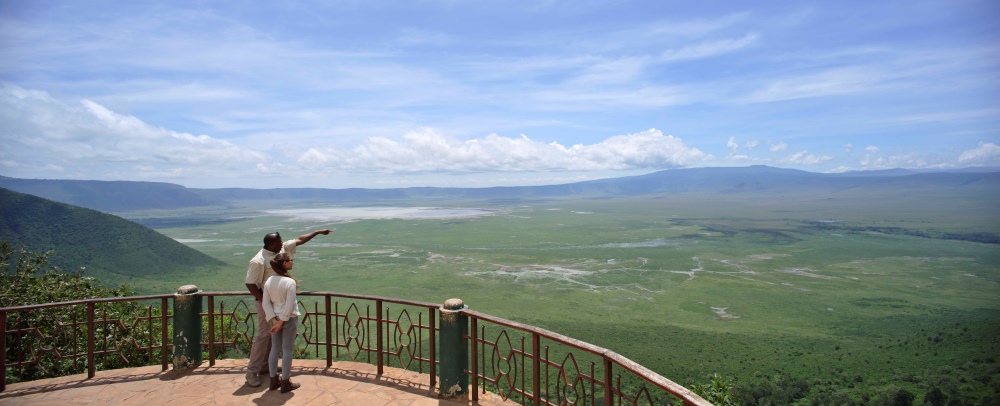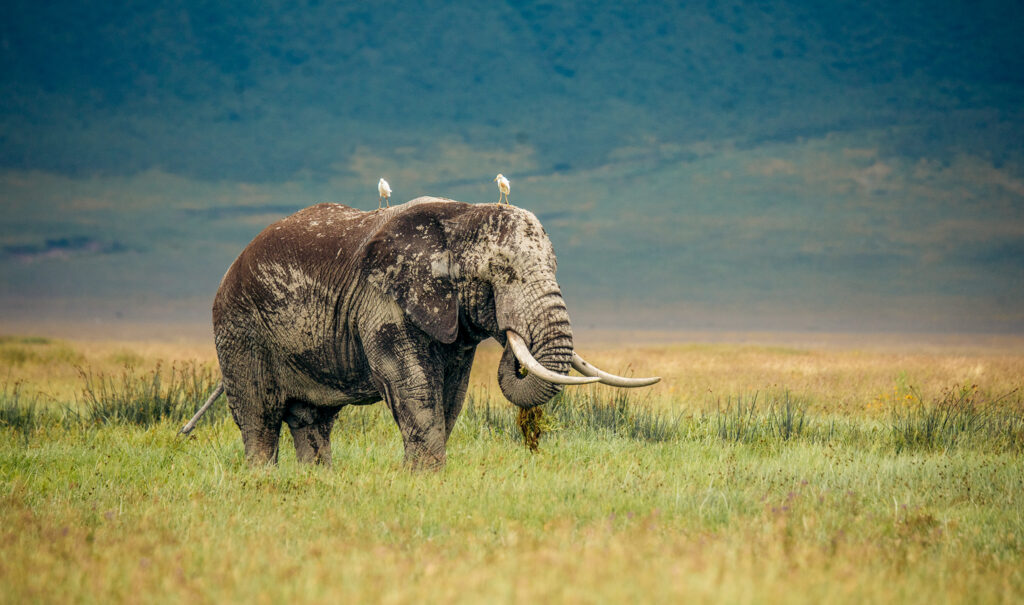Ngorongoro Crater
The Ngorongoro Conservation Area Authority encompasses the biggest unfilled and intact caldera globally. The Ngorongoro Crater measures around 20 kilometers in diameter, 600 meters in depth, and encompasses an area of 300 square kilometers. Nonetheless, Ngorongoro Crater is an awe-inspiring natural marvel. Ngorongoro Crater is a prominent site in Africa, renowned for its exceptional animal richness on the continent. The Ngorongoro Crater is regarded as one of the ‘eight wonders of the world.’ Furthermore, it ensures exceptional animal observation in an astonishing setting.

The floor of the Ngorongoro crater comprises several vegetative ecosystems, including grasslands, wetlands, woods, and Lake Makat (Maasai for ‘salt’). This region in Tanzania is the most probable location to observe the Black Rhino. Exceptional opportunities are available to observe leopards and splendid black-maned lions. Furthermore, many flamingos are attracted to the saline Lake Magadi.
The Ngorongoro Crater also offers opportunity for trips to Maasai villages, facilitating cultural immersion. This is one of the reasons for the establishment of the Ngorongoro Conservation Area. Thus, it safeguards the ecosystem for the nomadic Maasai community that migrates from the eastern Serengeti Plains. The nomadic Maasai establish temporary villages known as bomas, characterized by their circular structures. Opportunities now exist to visit several of these areas, as local communities have granted permission for tourists to access. This group possesses a distinguished history as combatants. Furthermore, they are prohibited from constructing communities within the park and from continuing to graze livestock in the broader Ngorongoro conservation area. Furthermore, they graze and consume water, irrespective of the proximity of predators.
Best time to visit Ngorongoro
The Ngorongoro Crater is an exceptionally unique and stunning location on Earth, and determining the optimal time to come will significantly improve your experience. This geological marvel, a collapsed volcano, is commonly known as the “Eighth Wonder of the World” and hosts a remarkable diversity of fauna, including the Big Five. When is the optimal time to feel its enchantment? The response is contingent upon various elements, including meteorological conditions, fauna, and population density.
The dry season, occurring from June to October, is regarded as the optimal period to visit the Ngorongoro Crater. In these months, the weather is predominantly sunny, with no precipitation, and the colder temperatures render safari drives more pleasant. Arid environments compel animals to gather near water sources, facilitating their visibility. The crater’s limited floor area results in species congregating in concentrated zones, offering excellent possibilities to observe substantial herds of elephants, buffalo, and predators such as lions and cheetahs.
The dry season is optimal for observing the renowned Big Five: lion, leopard, elephant, buffalo, and rhinoceros. At this time, the grass is shorter, facilitating visibility of wildlife, and the animals exhibit more activity. The Ngorongoro Crater, a year-round site, provides excellent wildlife observation at all times; however, the dry season enhances the likelihood of encountering a diverse array of species in close proximity. Moreover, reduced precipitation results in improved road conditions in and around the crater, facilitating access.
The wet season from March to May offers an ideal opportunity for anyone seeking a tranquil vacation in Ngorongoro. During this interval, the terrain is verdant and flourishing, adorned with exquisite blossoms and plentiful vegetation. Although the rain may render certain regions of the crater very muddy and more challenging to traverse, the scenery reaches its peak vibrancy, resulting in breathtaking vistas. The rainy season is characterized by the emergence of numerous newborn animals, particularly wildebeest and gazelles, providing an exhilarating opportunity to observe juvenile species in their natural habitat.
The wet season attracts less tourists, allowing for exploration of the crater without the typical throng. This enhances the experience, and for photography aficionados, the striking skies and verdant foliage provide ideal settings for breathtaking images. The weather is milder during the rainy season, characterized by brief, intense downpours that are typically succeeded by sunshine. This unpredictability introduces an aspect of adventure to your stay.
A favorable period to visit Ngorongoro is during the short rains from November to December. This is a transitional phase between the arid and humid seasons, during which the terrain starts becoming verdant, while the precipitation remains comparatively gentle. The brief rains produce a picturesque blend of arid and verdant landscapes, accompanied by a plethora of migratory birds coming in the region. This is an opportune moment to observe both indigenous fauna and migratory species.
To observe the Great Migration or other seasonal occurrences, it is optimal to schedule your visit during the short rains or the green season. The moist conditions invigorate the crater’s grasslands, attracting substantial herds of wildebeest, zebras, and gazelles from adjacent regions, creating a captivating display. Although less severe than the Serengeti migration, the Ngorongoro Crater nonetheless witnesses a remarkable influx of species during this period.
The optimal time to visit the Ngorongoro Crater is contingent upon your specific interests and desired experiences. The dry season provides the most reliable circumstances for optimal wildlife observation and improved access to the crater bottom, whilst the wet season presents a verdant environment and reduced visitors, resulting in a tranquil and scenic safari experience. The green season and short showers present distinct possibilities to observe young animals, migratory birds, and the remarkable alteration of the terrain.

Regardless of whether you visit in the dry season or the wet months, Ngorongoro Crater will provide you with indelible memories. The region’s fauna, striking topography, and extensive history render it an essential excursion for every safari aficionado. Regardless of the time of your visit, the crater’s allure and splendor will enchant you, rendering it an unparalleled experience.
Directions to the Ngorongoro Crater:
The Ngorongoro Crater is accessible via a drive from Arusha, which takes approximately 3 to 4 hours.
The Ngorongoro Crater may be visited by air during safaris via flights from Kilimanjaro International Airport or Arusha Airport to Lake Manyara Airstrip. Arusha Airport provides domestic flights, whilst Kilimanjaro International Airport facilitates both domestic and international flights.
